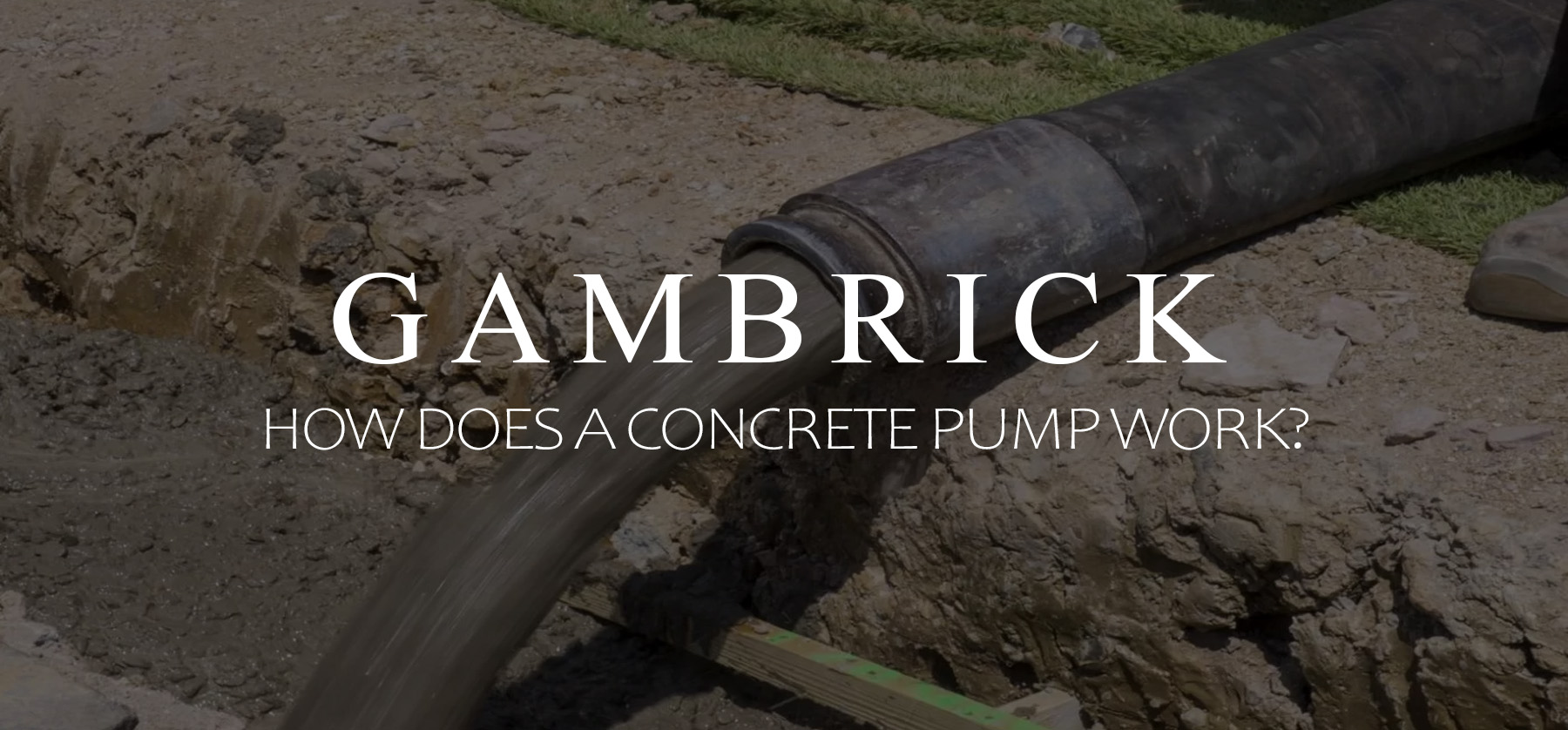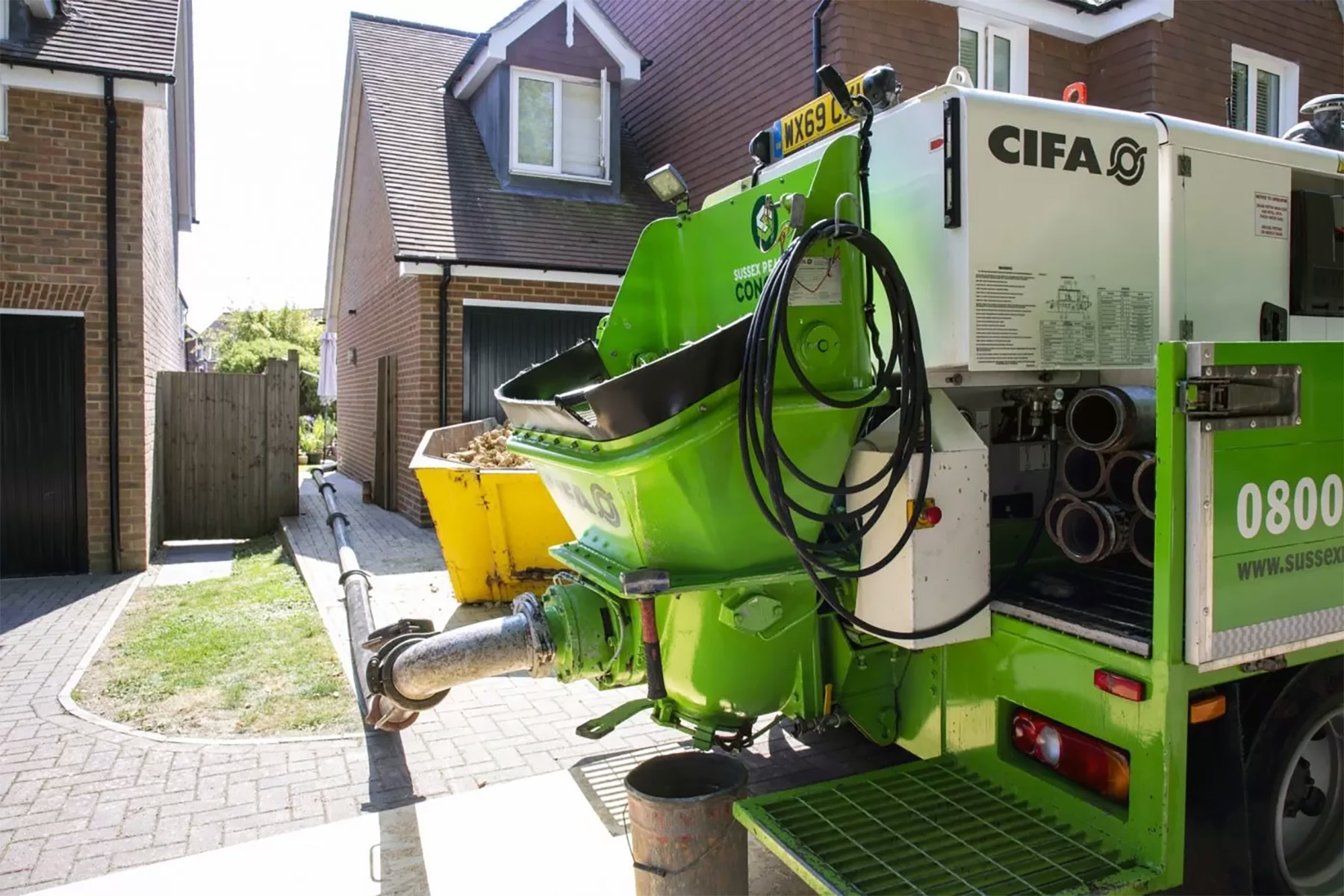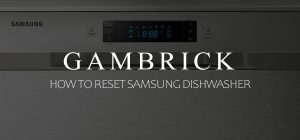
How Does A Concrete Pump Work?
A concrete pump is a machine that moves freshly mixed wet concrete. They use a valve system powered by hydraulics and a gas or diesel engine to move large volumes of wet concrete anywhere on a job site, through tight spaces, or to hard to reach locations. Concrete trucks mix concrete within a large rotating drum, then pour it into a hopper, which continues to churn the concrete so it doesn’t harden. From there, the concrete pump sucks wet concrete out of the hopper, through a valve system, out of the pump and through a series of hoses which can move concrete far away from the pump.
A twin-cylinder hydraulic concrete pump typically consist of two parallel cylinders. The cylinders have drive pistons inside that move them back and forth in opposite directions. As one cylinder moves forward, the other moves back.
The first cylinder, a.k.a. the material cylinder, pulls concrete out of the hopper. The second cylinder, a.k.a. the discharge cylinder, pushes the concrete out of the pump.
The two pistons work together to pull in and push out large volumes of wet concrete. The hydraulic flow created by the continuous flow of concrete is what causes the two cylinders to move back and forth. This continuous movement also keeps the wet concrete from hardening.
Concrete pumps are stationary and create concrete flow and pressure. But it’s the hoses that actually move concrete hundreds of feet around a job site.
I’ve been a mason for over 25 years and can tell you firsthand how essential concrete pumps are when combined with a concrete truck. They’re especially useful when used with curing blankets for cold weather work because they move the concrete quickly before it can harden.
How Concrete Pumps Work
Concrete pumps are machines designed to move concrete. Typically, a concrete truck delivers concrete to the site and dumps it into a hopper. The hopper is attached to the concrete pump. It has a mesh grate the concrete falls through to prevent large rocks or chunks from clogging up the hoses. The hopper also has an auger that spins and churns the concrete which keeps it from hardening.
Keeping concrete in constant motion prevents it from hardening, which prevents cracks. But if your slab does get a crack, repair it immediately with a concrete crack filler to prevent it from getting worse.
The pump has 2 valves that move in unison against each other. One valve sucks in concrete while the other pushes it out and through the hoses.
Concrete in the hopper gets sucked into the valve system in small intervals or strokes. Material is constantly being sucked in and pushed out as the pump cycles.
Concrete pumps have different types of valve systems called s-valves or ball-valves, but they work in the same basic way. As long as the hopper stays full and there are no blockages, concrete pumps through the hoses in a steady fluid stream.
Concrete shifts from one cylinder to the other providing a continuous flow of material through the piping system.
Pumps can be operated at a control panel located on the side or by remote control.
Safety and Stability of the concrete pump truck during operation is provided by the front and back outriggers. Controls for the outriggers are located on the sides of the concrete pump truck.
What Powers A Concrete Pump?
The way a concrete pump works is by hydraulics. Two cylinders that suck in and push out wet concrete from the hopper are hydraulically powered. That’s what gives a concrete pump it’s strength, which is measured in PSI or Pounds Per Square Inch.
It takes a lot of pressure to push concrete through a hose 100 or more feet long. Hydraulic power can even push material up and over a house and into multi story buildings.
All that hydraulic pressure is created by an engine.
Typically it’s a diesel powered engine but small pumps can be powered by gas.
Torque and durability are more important for this kind of work than horse power, and diesel engines supply plenty of both.
Regardless of the fuel source used, without a strong engine that creates hydraulic pressure, a concrete pump would be useless.
How To Operate A Concrete Pump?
How a modern concrete pump works, or is controlled, is by an electronic control panel. These controls are located on the side of the machine and/or a remote control.
In order for the machine to create hydraulic pressure, the engine has to be running. To turn the engine on you’ll have to turn a key, push an ignition button, or both. On some machines you may also have to turn on the fuel.
Most machines will have an emergency stop button. Make sure you know where this is in case you need it. Pushing it shuts off the engine and pump. You may have to pull it out to reset the machine which allows it to pump by blowing a horn.
The control panel typically has switches that adjust the direction of the flow, forward and backward, and flow speed.
Some machines can adjust concrete flow at the hydraulic pump independently from the engine. This a big plus because on these machines, concrete flow isn’t tied to engine speed. If you don’t have independent controls, the only way to increase flow is to run the engine faster.
Outriggers keep the machine steady as it pumps. Always make sure your outriggers are down and sturdily placed and never use a concrete pump without the outriggers in position.
Most pumps will have pressure gauges that indicate when pressure is high enough to start moving material.
When you’re ready, flip the switch that makes concrete flow through the pump. One person stays at the controls and adjusts flow and speed. Another person or persons works the hose and manages concrete as it shoots out of the hose.
The person working the machine needs to manage engine speed and hydraulic pressure to make the pump push concrete at the speed you want.
Types of Concrete Pumps
Concrete pumps come in two basic designs, ground line and boom. They work on the same basic technology but have some big difference in how they’re used.

Concrete Ground Line Pumps
Concrete ground line pumps pump wet concrete at ground level.
The way a ground line concrete pump works is very simple. The pump sits stationary at ground level. Long hoses attach to the pump which can be snaked all over a job site pumping concrete into crawl spaces, basements or other hard to reach places.
The benefits of a concrete ground line pump includes:
- Minimal effort means low labor
- Very precise which leads to less wasted concrete
- Easy to get concrete in hard to reach areas
Below are a few examples of ground line pumps:
- Stationary Pump: A stationary pump is the most basic form of concrete pump. It consists of a concrete pump mounted onto a small trailer. A different truck pulls the concrete pump around similar to a cement mixer. They do not have a boom or hoses, so separate pipelines or hoses are needed to carry concrete from the pump to where it needs to go.
- Truck-Mounted Static Pump: Truck mounted static pumps are permanently mounted onto a truck bed essentially becoming part of the truck. They don’t have booms or hoses, so separate pipelines or hoses are needed to carry concrete from the pump to where it needs to go.
- Truck Mixer Pump: This is an all-in-one design features a concrete mixer and a pump so it can pump concrete directly from the mixer. This model is efficient but requires a job site that allows for driving a large mixing truck close to where concrete will be poured. These also require additional hoses or piping to move the concrete from the truck to where its needed.

Concrete Boom Pumps
A concrete boom pump truck features a long boom that extends through the air to pump concrete wherever it needs to go.
They have a long, flexible, remote-controlled arm made up of articulated sections that include a flexible hose designed to move concrete. The arm extends into the air similar to a crane.
Boom pumps can be used for hard-to-reach areas that a line pump can’t reach, such as pumping concrete to the upper floors of a high-rise building. They can also reach right over houses to pump the concrete for swimming pools and patios.
When the boom is not in use, it folds up into smaller segments located on the back of the truck.
The benefits of a concrete boom pump truck includes:
- Easy to access more difficult areas, especially if they’re up high
- Less manpower needed
- Can help transport concrete around obstacles
- More precision with less effort
A boom truck can be driven close to a job site so extra hoses aren’t needed. High-rise concrete boom pumps can reach any area within reach of the boom. They can even feed concrete into stationary pumps to extend their range.
The articulated sections of boom pumps come in a few different configurations:
- Roll & Fold: The sections of a roll-and-fold pump folds in a curling motion. They’re best used in wide-open spaces because they need plenty of room to unfold.
- Z & ZZ: Sections fold back and forth like an accordion. They’re ideal for fitting through tight spaces or over and under obstacles.
- RZ: Also called multi-fold pumps, have sections that are a combination of roll-and-fold and Z.
Boom Trucks Feature Articulating Sections
Boom trucks feature articulating sections that curl and unfold in different ways like an arm with lots of joints. The amount of sections a truck has dictates how far and/or high the truck can pump concrete. Attached to the end of the articulating arm is a hose. The purpose of the arm is to get the hose into hard to reach places including up high.
When ordering a truck, make sure it has the section design you need and the correct length.
Boom pump trucks typically include four, five or six articulated sections for extended horizontal and vertical reach. Trucks have three, four or five axles, depending on the size and weight of the boom pump.
Remember, the truck has to be driven close to the job site to pump concrete where you need it. Don’t order a truck too large for your job or it won’t be of much use to you.
Boom Truck Sizes
Concrete boom trucks come in a variety of sizes which feature different amounts/lengths of articulating sections.
Here are a few common models:
- 57-meter 6-section RZ-fold boom pump: Concrete boom pump truck designed for medium and large construction sites. It features a vertical reach of 56.2 meters and a horizontal reach of 52.2 meters making it ideal for tall buildings and extremely hard-to-reach areas. Its six articulated sections give it a 360-degree mobility. Remote control allows for precise, easy concrete placement with minimal labor.
- 43-meter 5-section RZ-fold boom pump: A medium-sized concrete boom pump that’s ideal for commercial and residential construction projects. Featuring a vertical reach of 42.3 meters and a horizontal reach of 38.3 meters. Its compact truck body makes it easier to park in residential spaces. A remote-controlled arm makes it easy to navigate over or under tree branches and power lines.
- 33-meter 5-section ZZ-fold boom pump: A lightweight boom pump truck that’s ideal for hard to get to commercial and residential projects. It features five accordion folding articulated sections which allows it to reach into all kinds of hard-to-reach places. Its small size allows it to work in tighter areas.
Why Use A Concrete Pump?
A concrete pump greatly reduces the amount labor it takes to move concrete. A pump truck can transport concrete multiple floors up into a high-rise building. Can you imagine how much labor that would take without a machine doing the work for you.
Even when working at ground level a concrete pump saves times and labor. Have you even had to wheelbarrow concrete to the backyard of a house for a project? A pump truck can shoot the concrete right over the house or snake it around the side. I’ve never used them on a job where the cost wasn’t less than the labor I saved. Economically speaking, they’re worth the money.
Pumping concrete is fast and accurate which means less waste and cleanup. They save on labor costs and reduce wasted material.
Even using a concrete power-buggy isn’t as easy or accurate as a pump. With a pump truck, you can shoot the concrete to the exact place you need it with almost zero hard labor.
Common Applications For Concrete Pumps
Concrete pumps are used in a wide variety of construction projects.
- Slabs: Concrete pumps are great for pouring slabs. You can move the hose into position and shoot concrete exactly where you need it. This is a big benefit when working on a large slab because you don’t have to push around as much concrete with a bull float.
- Basements: Concrete work in a basement can be difficult. Without a pump, you need chutes that bring material from ground level into the basement. Then you have to move it around. It’s much easier to pump the concrete exactly where you need it.
- High-Rise Buildings: Construction work gets harder the higher you go. A pump truck can be a huge benefit here because concrete can be shot exactly where you want it by the truck. This saves a ton in labor expenses. It also cuts down on job-site accidents.
- Pools: I always shoot concrete when building concrete pools. Spreading material onto the walls would be much harder without a pump.
- Crawl Spaces: If your project is in a hard to get to place and requires concrete, a pump can be an enormous benefit.
How Have Concrete Pumps Changed The Construction Industry?
Concrete pumps have been a huge benefit for the construction industry. almost all large scale construction projects built today use concrete. This includes foundations, bridges, damns and large scale buildings. Imagine mixing and transporting all that material without machines. Pumps make work faster and easier which saves money and cuts down on job site accidents.
Pumps have been a huge benefit for high-rise construction. In the past, cranes had to lift material into the air where it was carried by hand where it was needed. Everything was done by workers. And working gets more dangerous the higher you go. It’s much faster and easier to use machines. And more precise.
Concrete pumps are more efficient too. And can move large amounts of concrete at a time. Because material is always flowing, workers are always busy doing skilled work, not manual labor.
How Much Does A Concrete Pump Cost?
Small residential jobs with a trailer-mounted pump and 200′ hose costs around $15 per cubic yard with a $125 minimum. But larger jobs that require a 75′ to 105′ boom truck range in price from $150 to $200 per hour with a typical 4- to 5-hour minimum. That’s in addition to the cost of the concrete.
What Type Of Pump Is best For Concrete?
It’s hard to say which type of pump is best because it all depends on your project. I use both boom and ground level machines on my jobs. They both work great but are good for different things.
I’ll give you a few examples based on jobs we’ve done.
- If I have to shoot concrete into a crawl space or basement I always use a stationary machine. They’re not that expensive to rent and hook up to the back of a full size pickup pretty easy. It’s like towing a mixer or large trailer. Booms aren’t much help for low work.
- When I’m working on a pool it’s a toss up. I prefer the boom because it can position into the center of the pool and then I can angle it to the side walls. It’s a little bit less labor than a ground level machine.
- For patios or other flat work, it’s a toss up here too. But I prefer the boom. Having the concrete spray down rather than sideways makes the job easier. And I don’t have to lug the hose around. A good operator can get the arm right where I need it.
- Booms are more expensive, so for smaller jobs I typically use a stationary machine.
How Long Does It Take To Pump Concrete?
Most pumps can move 30 to 100 cubic meters of concrete per hour. That’s about 40 to 130 cubic yards of concrete or 4 – 13 full truck loads. If you’re not familiar with concrete work, this is fast. And most importantly it’s very precise. You can shoot concrete exactly where you need it with very little waste.
The setup time for concrete pumps is also very fast. They can be pumping concrete in minutes after arriving on site. All you do is hook up the hoses, turn them on and fill them with material. Typically the hopper comes attached and ready to go.
How long it takes to pump concrete on your job depends on how much material you need and what type of job it is. Remember, you still need to move the hose or articulating arm around the job. If the work is in one tight area that’s gonna be faster than if the job is spread out.
How Far Can Concrete Pump Trucks Reach?
Ground line hydraulic pumps can move concrete at about 1m³ per minute and can extend to a distance of around 150 meters. This is much longer than the biggest pump trucks which only reach about 57 meters. The reason is weight.
Stationary pumps are only moving material through hoses, so all that matters is the strength of the hose and pump. But pump trucks have to support the hose, material and the weight of the articulating arm as it moves through the air. This means the distance a truck can pump concrete is much less.
Here’s a breakdown of average truck sizes and how far they can move concrete:
- 57-meter 6-section RZ-fold boom pump: Concrete boom pump truck designed for medium and large construction sites. It features a vertical reach of 56.2 meters and a horizontal reach of 52.2 meters making it ideal for tall buildings and extremely hard-to-reach areas. Its six articulated sections give it a 360-degree mobility. Remote control allows for precise, easy concrete placement with minimal labor.
Summary: How Does A Concrete Pump Work?
A concrete pump is a machine that moves freshly mixed wet concrete. They use a valve system powered by hydraulics and a gas or diesel engine to move large volumes of wet concrete anywhere on a job site, through tight spaces, or to hard to reach locations. Concrete trucks mix concrete within a large rotating drum, then pour it into a hopper, which continues to churn the concrete so it doesn’t harden. From there, the concrete pump sucks wet concrete out of the hopper, through a valve system, out of the pump and through a series of hoses which can move concrete far away from the pump.
A twin-cylinder hydraulic concrete pump typically consist of two parallel cylinders. The cylinders have drive pistons inside that move them back and forth in opposite directions. As one cylinder moves forward, the other moves back.
The first cylinder, a.k.a. the material cylinder, pulls concrete out of the hopper. The second cylinder, a.k.a. the discharge cylinder, pushes the concrete out of the pump.
The two pistons work together to pull in and push out large volumes of wet concrete. The hydraulic flow created by the continuous flow of concrete is what causes the two cylinders to move back and forth. This continuous movement also keeps the wet concrete from hardening.
Concrete pumps are stationary and create concrete flow and pressure. But it’s the hoses that actually move concrete hundreds of feet around a job site.
I’ve been a mason for over 25 years and can tell you firsthand how essential concrete pumps are when combined with a concrete truck. They’re especially useful when used with curing blankets for cold weather work because they move the concrete quickly before it can harden.
If you have any questions email or leave a comment below.

John Mazzuca | About | More Posts |
Custom Home Builder
John Mazzuca is a custom home designer and builder at Gambrick with over 25 years experience in the construction industry. John has designed, built and/or remodeled hundreds of homes, small buildings, and commercial projects. He writes about business, real estate, home building, and household electronics. His work has been featured in Fox Business, Better Homes & Garden, House Beautiful, and more.




















